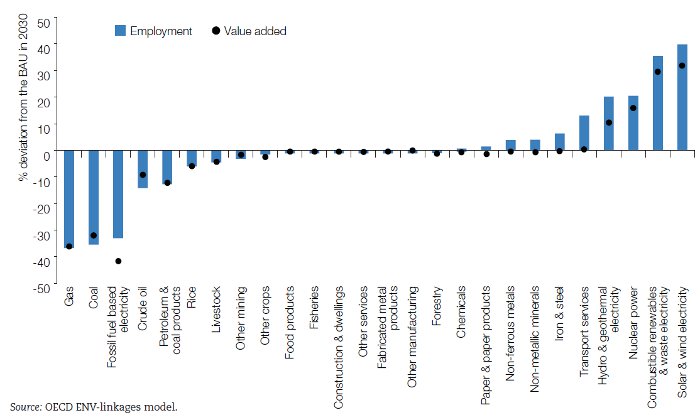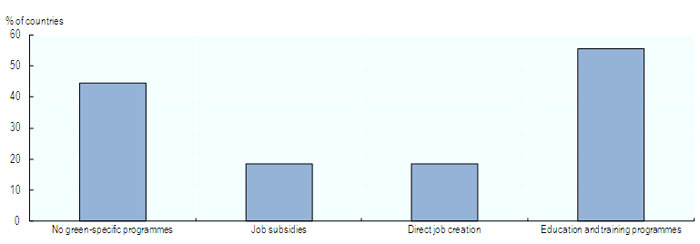G20 › Topics › Employment-and-social-policy › Greening jobs and skills
Greening jobs and skills
|
A successful transition towards a greener economy will create new opportunities for workers, but also new risks. The challenge for labour market and skill policies is to maximise the benefits for workers and help assure a fair sharing of adjustment costs, while also supporting broader green growth policies (e.g. by minimising skill bottlenecks). The four main policy priorities are:
|
|
There is also a need for inclusive green-specific labour market and skill policies, including top-up training for mid-career workers who need to adapt to greener ways of working, and ensuring that both men and women are equally well-prepared for the shift to a greener economy.
How do climate change and employment influence each other?
Sectoral changes in employment with ambitious climate change mitigation policies, OECD countries
In % deviation from the business-as-usual (BAU) scenario in 2030

Economic modelling suggests that ambitious climate-change mitigation policies could be good for jobs as well as the environment. A study using the OECD’s ENV-Linkages model shows that a well-designed emissions trading system could sharply reduce GHG emissions while allowing GDP to keep growing (although at a slightly lower rate). The key is mobility, with workers able to move easily from sectors where employment would drop, notably fossil-fuel industries, to sectors such as renewable energy industries where job opportunities rise rapidly. Countries exporting fossil-based energies would be most affected.
OECD modelling indicates small net impacts on total employment, but other studies show bigger gains if the right policies are in place. These studies also show that green growth could be a powerful weapon to help developing economies in their fight against underemployment.
The OECD model demonstrates that the impact of GHG mitigation policy on GDP growth is small when the labour market adjusts smoothly to employment opportunities and losses, but that the costs rise significantly when workers in declining sectors become unemployable elsewhere due to an incapacity to change and lack of flexibility in labour markets. One way to combine environmental policy with measures to help workers take advantage of new opportunities would be use revenues from carbon taxes to reduce taxes on labour income. This can generate a “double-dividend” by delivering both lower GHG emissions and higher employment.
Work on SMEs, entrepreneurship and innovation has shown that there will be a need for new types of skills to match new types of jobs, as industry is transformed into a low-carbon economy. “Green and silver jobs” are expected to grow and there will be a marked shift towards business services jobs in advanced economies. Even in the most negative scenario, more than 80% of jobs by 2020 are expected to require medium and high levels of skills while low-skills jobs will continue to decline. These high-level green skills will be necessary to adjust to the green transformation of the economy. Green skills include specific skills to modify products, services or operations due to climate change adjustments, requirements or regulations.
An OECD questionnaire sent to labour and employment ministries reveals that about 60% of the responding countries have implemented at least one green growth labour market measure, with training being the most common. By contrast, job subsidies in private sector or direct job creation in the public sector are only rarely used as green employment measures which indicates green labour market measures still at an early stage of implementation. In addition, green components have been progressively integrated into general labour market programmes in a number of the countries reporting no green-specific programmes, indicating that great caution is required when comparing green-specific initiatives in the field of labour market and skill development policies in different countries.
Green-specific national labour market programmes implemented by OECD countries, 2010

Note: The OECD questionnaire on green jobs and policies covers 27 OECD countries. The columns sum to more than 100% because many countries operating green-specific measures reported making use of multiple types of measures.
Source: OECD questionnaire on green jobs and policies.
From the demand side, an OECD survey of small and medium-sized enterprises indicates that firms are often not sufficiently aware of the need for green skills for the future, and their investment in green training or green knowledge-intensive activities is often limited, as is their awareness of the impact of regulations on their industry. It also shows the important role than local partnerships can have on fostering rich skills and training ecosystems.
Dedicated green education and training programmes will have an important role to play in helping workers to participate fully in the emerging green economy. Evidence from a number of countries suggests that skill shortages have already developed in certain sectors or occupations where green growth policies have created a need for new skills, or new combinations of familiar skills.
Women’s under-representation in science, technology, engineering and mathematics fields in tertiary education directly limits women’s opportunities to participate in a growing green labour market. In the majority of OECD countries, fewer than 30% of tertiary qualifications in the fields of engineering, manufacturing and construction and about 40% of tertiary qualifications in science degrees were awarded to women. Gender differences in these subject choices are even more distinct in vocational training programmes. If green content is introduced only in science and engineering oriented vocational programmes, a large proportion of women will not benefit from the training and miss the opportunity to acquire the necessary skills for new green jobs.
Current OECD work
The OECD Employment Outlook 2012 will include a chapter looking at the policy challenges posed by green growth and jobs, developed in conjunction with the European Commission. The chapter will draw on the report The Jobs Potential of a Shift towards a Low-Carbon Economy.
The OECD has also worked with the ILO to support a G20 initiative to foster the greening of labour markets in countries at all levels of economic development.
The OECD-CEDEFOP Forum on Green Skills brings together researchers, government advisers, employment and policy analysts and social partners actively involved in skills development and training needs for a low carbon economy to review and discuss new research, strategic and policy approaches to foster a greener, more sustainable future. It identifies tools, strategies and local initiatives from theory to practice.
Building capacity at a local level will be essential to effectively support job creation in the transition to a green economy. The Climate Change, Employment and Local Development project aims to help national and local authorities put in place good quality greener jobs by developing lower-carbon activities. The project report suggests that there are some barriers that need to be identified and overcome in order to ensure an effective transition to greener growth.
The project Measuring the potential of green growth aims to define measurable indicators at regional/local level that can inform the transition to low-carbon economic and industrial activities. Chiefly the project looks into ways to foster job creation and inclusive economic development in new areas of growth and sustainable development.
A follow-up project on improving the effectiveness of green local development initiatives focuses on identifying approaches to support leveraging of public sector green projects to foster local development activities such as firm competitiveness and job creation in the area where the projects are based. These approaches will look at ways in which the public sector can improve the impact of large green projects (e.g. energy or transport) on the socio-economic development of a local labour market.
Upcoming events
|
11/12 Jun |
International Workshops: Indicators of Local Transition to Low-Carbon Economy. Ghent, Belgium / Belval, Luxembourg |
|
03-04 Jul |
Capacity building seminar: Strategic approaches to demographic change in Russia and Eastern Europe (Trento, Italy) |
|
10-12 Oct |
Education for Sustainability | International Greening Education Event. Karlsruhe, Germany. |
Further reading
Related Documents



Follow us
E-mail Alerts Blogs